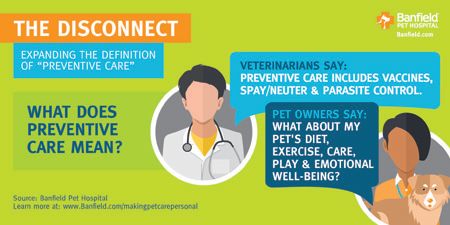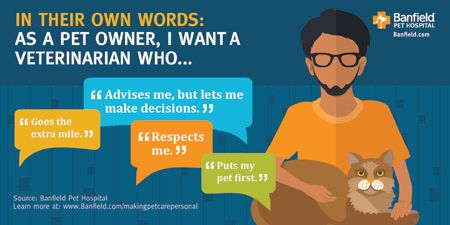Banfield uncovers gaps in preventive care definitions
Pet owners and veterinarians view elements of wellness very differently.

For its annual State of Pet Health Report, a research undertaking that has historically looked at chronic conditions, infectious disease and other pet health trends using its vast database of patient visit information, Banfield Pet Hospitals took a different approach this year.
In 2015, instead of deploying its BARK (Banfield Applied Research and Knowledge) statistical team or sending out surveys, Banfield decided to listen. Or, put a different way, to lurk. Or, to use yet another phrase, to engage in an “online anthropology” exercise.
What that means is that Banfield read more than 2 million blogs, social media posts and online forums to figure out what pet owners were saying to one another and how they viewed veterinarians and veterinary care.
Behind this effort, of course, as in previous years, is the concern that the pet population is growing and visits to the veterinarian are shrinking, along with the impact of those realities on overall pet health in the United States.
One key finding was a major difference in how pet owners define preventive care and how veterinarians define it. To veterinarians, preventive care involves vaccinations, spaying and neutering, and parasite control. To a pet owner, preventive care means diet, exercise, care, play and emotional well-being. In keeping with this attitude, they consider daycare providers, boarders, groomers, breeders and trainers as essential to their pets' well-being. Furthermore, 81 percent of pet owners believe that they are responsible for their pet's preventive care, while 19 percent believe it's the responsibility of the pet's veterinarian.
All of this is juxtaposed with the finding that dog owners are comfortable waiting 16.9 months between visits to the veterinarian, while in 2011 that number was 11.4 months.
Banfield also looked at what pet owners search for online. They found that the most commonly Googled topics are behavior, health concerns (“vomiting” being the top term in this category), breeds and genetics, and food, nutrition and diet.
This brings to light a need for veterinarians to focus on areas of pet area concern and position themselves as partners in the pet's healtlh. “We want a seat at the table-preferably at the head of the table-with other trusted sources like breeders, trainers and groomers so we can partner with them to ensure that pets are getting the care they need,” the State of Pet Health Report reads.
Jeannine Taaffe, a senior vice president with Banfield, says the company will be making changes to its own hospitals along with sharing its findings with the profession. “What we've done in the past is not going to take us into the future,” she says.

